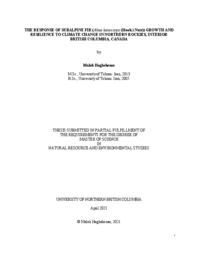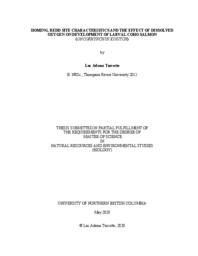Pypker, Thomas
Person Preferred Name
Thomas Pypker
Related Works
Content type
Digital Document
Origin Information
Content type
Digital Document
Description / Synopsis
Understanding forest growth and resilience under global climate change is crucial for forest management, to maintain wood supply for future. In this research, I focused on the response and resilience of subalpine fir (Abies lasiocarpa (Hook.) Nut)) growth to climate variables and severe drought events at five stands located along northern slopes of the Rockies in northern BC, Canada. Results revealed that temperature (especially summer and previous fall) was the most important climate factor controlling growth of subalpine fir trees at study sites. The lower the latitude, the more summer temperature negatively effected tree growth. Also, results showed that subalpine fir trees were resilient to very dry conditions at study sites, when considering the growth recovery period to drought was between 1 to 2 years. The lower the latitude, the faster the trees recovered from drought. However, subalpine fir trees located at higher latitudes were more resistant to the effects of drought.
Origin Information
Content type
Digital Document
Description / Synopsis
Life histories of Pacific salmon are remarkable in that they return to specific freshwater sites to spawn after multiple years of ocean residence. In Chapter 1, I investigated site fidelity at a reach scale for Interior Fraser Coho Salmon (Oncorhynchus kisutch) (IFC). Coho Salmon eggs were incubated at known spawning locations in the Coldwater River, British Columbia, to obtain reference data for comparison to otolith signatures of returning adult salmon. The majority of adults (67%) returned to their natal spawning locations at the reach scale, while 33% strayed to other spawning sites within the Coldwater River, illustrating straying at small scales. Straying to novel incubation sites at the reach scale demonstrated plasticity in homing within a watershed. In Chapter 2, I investigated the characteristics of the hyporheic redd zone over two years where Coho Salmon were observed to spawn. Within a reach, physical variables were homogenous, but heterogeneity was found among reaches where Coho Salmon were observed to spawn – particularly for intragravel temperature and dissolved oxygen. The difference in temperature and dissolved oxygen among sites had a pronounced effect on survival, rate of development, and emergence time for Coho Salmon fry. Heterogeneity among spawning locations demonstrate trade-offs that exist between rate of development and survival. Chapter 3 investigated the effect of low and variable dissolved oxygen on developing salmon embryos. A family effect was found as smaller eggs produced smaller alevin, but the effect of low dissolved oxygen on growth was also greater for the families with small eggs. Treatment affected rate of development and initially had an effect on length and mass, but by button-up there was no longer an effect of low dissolved oxygen on size. My work demonstrates plasticity in Coho Salmon at different life stages. Plasticity is important for utilizing new habitats or adapting to existing habitats as they change.
Origin Information
Content type
Digital Document
Description / Synopsis
Carbon (C) storage in residual live lodgepole pine trees in northern BC at Kennedy Siding was measured 11 and 12 years after a severe mountain pine beetle (MPB) epidemic. Kennedy Siding eddy covariance (EC) measurements showed that the net ecosystem productivity (NEP) was quick to recover C sink status. In this study, measurements of heights and diameters of 160 residual live lodgepole pine trees and a subset of 60 tree cores were used to calculate residual tree stem C-storage in 2017 and 2018 (36.01 and 26.71 g C m-2 yr-1 respectively). Dendrochronology analyses indicated that residual pine trees released on average 392% in the decade following versus the decade prior to MPB-attack. Stem C-storage was strongly and positively correlated with ECNEP measurements (R2=0.77) and percent downed canopy trees (R2=0.837), suggesting that growth release of residual trees was likely driven by improvements in resources (e.g. light, moisture, nutrient).
Origin Information




